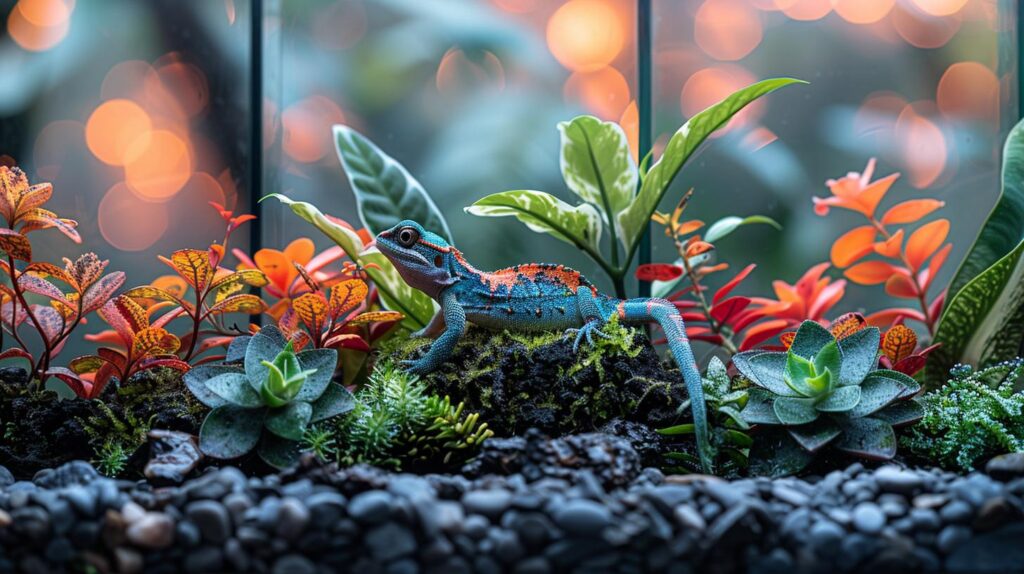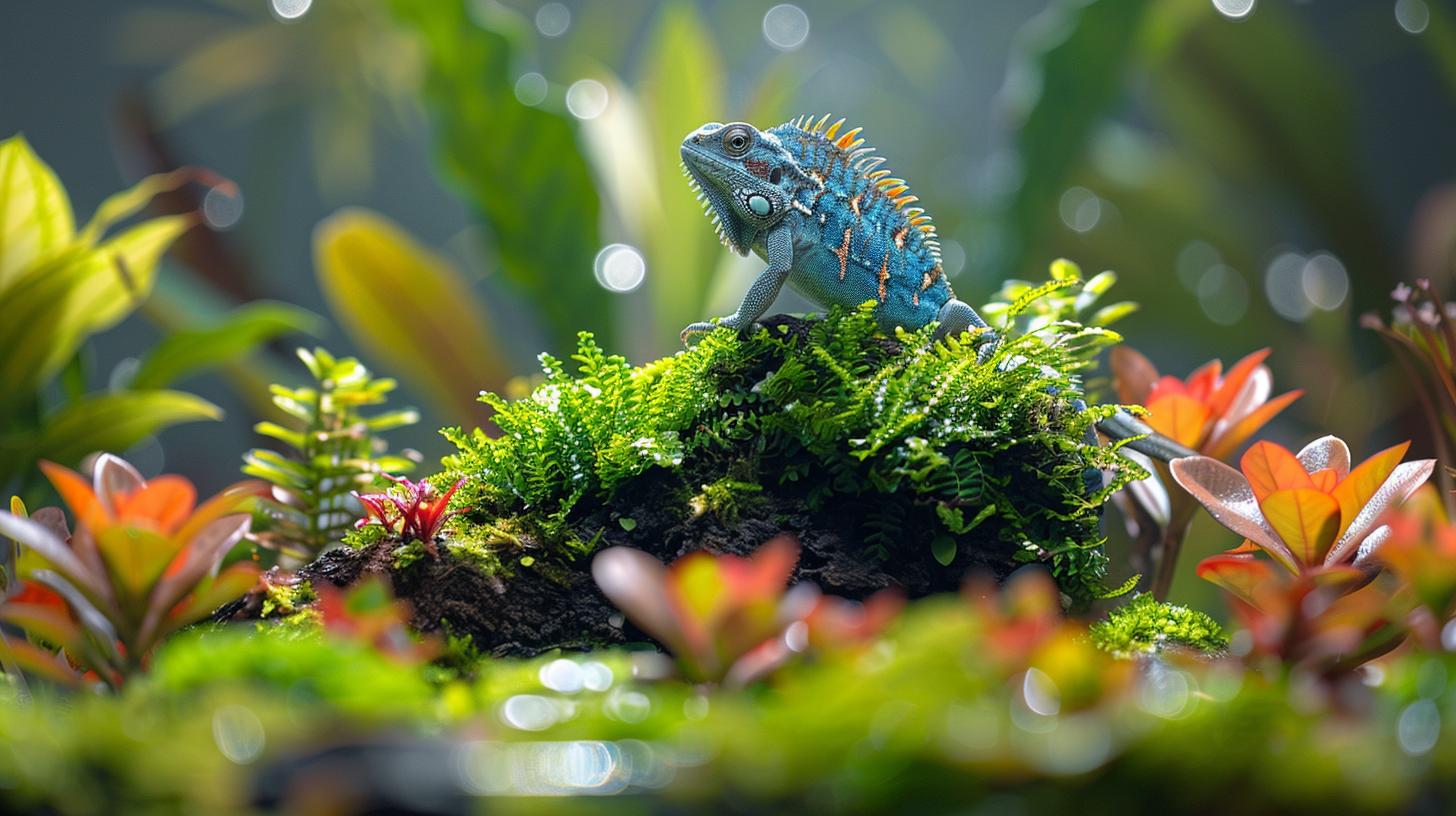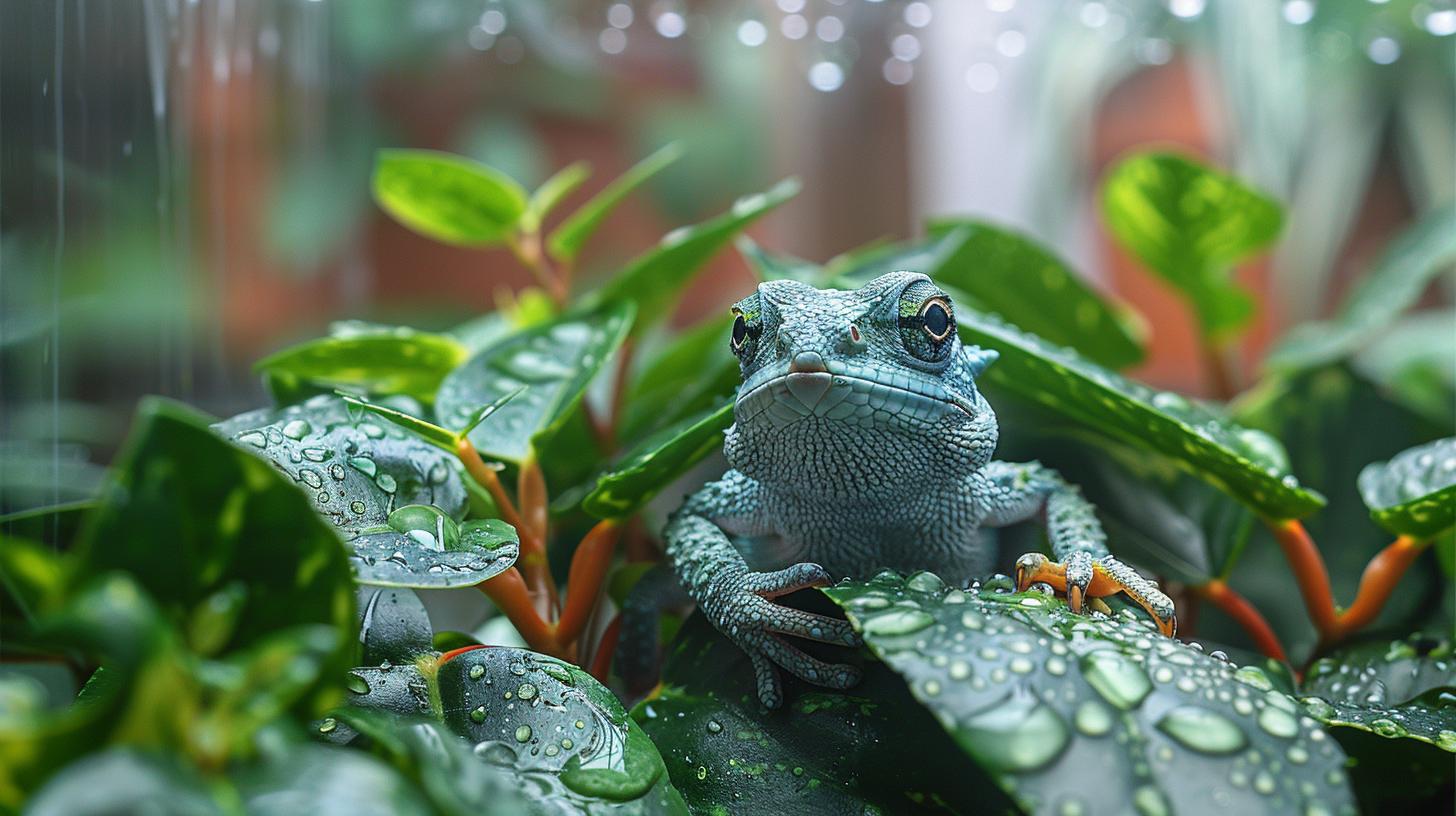5 Key Tips to Shield Your Terrarium Reptiles From Stress and Disease

Understanding Stress and Disease in Terrarium Reptiles
Creating a serene sanctuary for your terrarium reptiles involves more than just providing them with food and water; it's about ensuring their environment is conducive to their physical and emotional well-being. Stress and disease can significantly impact the health of these sensitive creatures, making *shielding terrarium reptiles* from such adversities an essential aspect of their care.
Understanding the intricate balance between their physiological needs and psychological comfort is the first step toward fostering a stress-free habitat that promotes their longevity and happiness.
The concept of stress in reptiles, much like in humans, encompasses both physical and mental aspects, affecting their immune system and making them more susceptible to diseases. Factors contributing to stress include inadequate habitat conditions, improper diet, lack of routine healthcare, and insufficient handling techniques.
By examining reptile physiology and psychology, we get a clearer picture of what constitutes a healthy living environment for these unique animals. Recognizing the signs of distress early on plays a crucial role in mitigating long-term health issues, thus underscoring the importance of establishing a comfortable habitat that mimics their natural surroundings as closely as possible.
Moreover, creating a proper habitat is pivotal in reducing stress levels among terrarium dwellers. Critical elements such as accurate temperature gradients, appropriate humidity levels, and ample space not only mirror the conditions of their wild habitats but also significantly minimize potential triggers for stress.
This harmonious environment enables reptiles to exhibit natural behaviors, thereby enhancing their overall well-being. As we delve into factors like diet and nutrition, which are equally vital in fortifying reptiles' immune systems against stress-related diseases, it becomes apparent how interconnected each aspect of their care truly is.
Practice in regular handling techniques similarly contributes to lowering stress among terrarium inhabitants by acclimating them to human interaction gently and respecting individual tolerance levels. Balancing these aspects with vigilant cleanliness and hygiene further asserts the significance of each measure taken in protecting these fascinating pets from harm's way.
Starting with this foundational understanding paves the path for incorporating detailed strategies aimed at maintaining optimal health conditions within the terrarium-each proving indispensable in safeguarding reptiles against detrimental stress and illness.
The Importance of a Proper Habitat
Creating a proper habitat for terrarium reptiles is not just about aesthetics; it's a crucial aspect of their well-being, directly impacting their health and longevity. Reptiles, being ectothermic creatures, rely on their environment to regulate their body temperature. This fact underscores the necessity of designing enclosures that mirror their natural habitats as closely as possible.
Providing the optimum balance of temperature, humidity, lighting, and space caters to the psychological and physiological needs of these animals. It's the foundation upon which all other aspects of care rest, emphasizing the importance of getting it right from the start.
Understanding and replicating the specific conditions of your reptile's natural habitat is fundamental. Desert species such as bearded dragons require a dry environment with hot basking spots while tropical species like chameleons thrive in more humid conditions with ample foliage for hiding.
Failure to meet these basic needs can lead to stress, weakening their immune systems and making them more susceptible to disease. Therefore, this section delves deeper into how creating an adequate living space can aid in shielding terrarium reptiles from these potential issues.
Temperature Gradients: The Hot and Cool of It
For terrarium reptiles, maintaining a proper temperature gradient within the enclosure is essential for thermoregulation-a process vital for digestion and overall metabolic function. A well-designed habitat should have distinct warm and cool areas, allowing reptiles the ability to self-regulate their body temperatures by moving between zones.
Using heating lamps or pads on one side while keeping the other end cooler simulates this natural environmental condition effectively. Regular monitoring with accurate thermometers ensures that these temperate zones remain consistent with what each specific species requires for optimal health.
Humidity: The Invisible Necessity
Humidity levels are another critical parameter in creating a suitable environment for terrarium dwellers. Each species has its own requirement: too low, and you risk dehydration; too high, and your pets may suffer from respiratory infections or skin issues like scale rot.
Implementing solutions like misting systems or humidifiers-paired with reliable hygrometers to monitor moisture levels-can help achieve that perfect humidity balance necessary for your reptiles' survival. Remember, variations exist even within species; doing thorough research or consulting with experts on ideal humidity ranges is advisable.
As practitioners of responsible reptile care understand well, attending meticulously to these habitat essentials goes beyond mere comfort-it's about providing a foundation for health and vitality in your pet's life every day. By prioritizing an understanding of your pet's elemental needs within its enclosure design, you're taking significant steps toward shielding terrarium reptiles from stress and disease successfully.
Diet and Nutrition
Proper diet and nutrition are foundational to maintaining the health and welfare of terrarium reptiles. These cold-blooded creatures have unique dietary requirements that vary significantly across different species. For example, while some reptiles thrive on a carnivorous diet, others may require a mix of fruits, vegetables, and insects to meet their nutritional needs. Understanding these nuances is crucial in *shielding terrarium reptiles* from stress and potential diseases linked to malnutrition or improper feeding practices.
A common oversight by many reptile owners is underestimating the importance of variety in their pet's diet. Just as humans benefit from a wide range of nutrients obtained from diverse food sources, so do reptiles. Incorporating a balanced mix of proteins, vitamins, minerals, and hydration supports not only physical health but also mental wellbeing.
It reduces the risk of obesity, organ malfunction, and vitamin deficiencies that could otherwise lead to more severe health issues. Regularly consulting with a veterinarian knowledgeable in reptile nutrition can help tailor a diet plan specific to your pet's species, age, and health condition.

Moreover, how food is presented can play an enormous role in emulating natural feeding behaviors-encouraging foraging activities among terrarium dwellers stimulates mental activity and prevents boredom-related stress. This aspect of dietary planning underscores the connection between physical health and psychological well-being-an essential consideration for anyone aiming to provide optimum care for their terrarium residents.
| Factor | Importance |
|---|---|
| Nutritional Variety | Vital for balanced intake of nutrients. |
| Food Presentation | Encourages natural behaviors and reduces stress. |
Adopting these principles into your care routine reinforces the shield against various stresses and illnesses that terrarium reptiles might face. While investing time in understanding each species' specific needs might seem overwhelming at first glance, it's an integral part of responsible reptile ownership.
As we progress through this guide on enhancing the lives of our scaled friends within their glass homes, remember that every effort made towards optimizing their diet is a step closer to ensuring their wellbeing-a commitment they silently rely upon us to fulfill.
Regular and Proper Handling Techniques
Handling techniques play a pivotal role in the well-being of terrarium reptiles, making it imperative for owners to master the art of interaction that minimizes stress and promotes trust. When considering shielding terrarium reptiles from unnecessary anxiety or discomfort, understanding their unique needs and responses becomes as critical as providing them with the right habitat or diet.
This part of our guide focuses on how regular, yet mindful handling can significantly contribute to maintaining your reptile's health and emotional well-being.
Firstly, it's essential to gradually acclimate your reptile to human touch. Start by letting them get used to your presence around their terrarium, moving slowly to avoid startling them. Over several days or weeks, depending on the reptile's species and individual personality, introduce your hand into their environment without attempting to touch them.
Allow them to investigate you on their terms. When you do begin the actual process of handling, ensure it's in a quiet place where they feel secure. For many reptiles, especially those not traditionally known for their sociability, this slow introduction can make a world of difference in reducing potential stress.
- Begin with short handling sessions, progressively lengthening the time as they become more comfortable with human contact.
- Avoid sudden movements that might startle or threaten your reptile during these interactions.
- Recognize signs of distress, such as hissing, retreating, or any aggressive behavior indicating it's time to end the session.
It's also worth noting that each species-and indeed each individual-has its own tolerance levels for interaction. Some may never enjoy being handled extensively but can learn to tolerate brief interactions without undue stress.
Moreover, implementing proper handling techniques isn't just about reducing immediate stress; it's about long-term health benefits too. Stress-free handling can help prevent injuries resulting from attempts to escape or retaliate. It also plays a part in screening for signs of illness since close observation during handling may reveal issues like skin lesions, abnormalities in weight or posture that would otherwise go unnoticed until more advanced stages of disease.
In continuation of our exploration into maintaining healthy lifestyles for terrarium-dwelling reptiles, this emphasis on specialized care routines underscores not only the importance of a proper habitat but introduces a nuanced perspective on direct interaction strategies as profound tools in an owner's arsenal against stress and disease among these sensitive creatures.
The following sections will delve deeper into cleanliness hygiene practices and regular monitoring for signs of illness - other vital components in ensuring longevity and quality life for our scaled companions.
Maintaining Cleanliness and Hygiene
Maintaining a pristine environment is paramount in safeguarding the health of terrarium reptiles. A clean habitat not only prevents the occurrence of stress-induced behaviors but also significantly reduces the risk of infectious diseases, which can be exacerbated by unsanitary conditions.
This crucial aspect of reptile care often goes overlooked, yet it wields immense power in bolstering the immune systems of these sensitive creatures. By instituting a regime of regular cleaning and monitoring for contaminants, pet owners can ensure that their reptilian companions lead healthier, more vibrant lives.
In understanding the direct link between hygiene and health, it becomes clear that preventing disease is much simpler than treating it after onset. The presence of waste materials, leftover food, and stagnant water can quickly become breeding grounds for harmful bacteria and parasites.
These unwelcome guests not only pose immediate health risks but can also contribute to long-term stress for terrarium dwellers. Therefore, keeping a vigilant eye on cleanliness within the habitat is akin to shielding terrarium reptiles from potential threats before they have a chance to manifest into something more sinister.
Creating a Cleaning Schedule
Implementing a systematic cleaning routine is essential for maintaining an impeccable terrarium environment. This involves daily spot checks for removal of waste and uneaten food, weekly substrate changes or cleanings as appropriate for your specific type of reptile's habitat, and monthly deep cleanings where every component of the terrarium-decorations included-is thoroughly sanitized. Such rigorous routines might seem daunting initially but establishing these habits early on ensures that maintaining cleanliness becomes second nature over time.
Choosing Appropriate Cleaning Agents
When sanitizing a terrarium, selecting pet-safe disinfectants is critical to avoid inadvertently exposing your reptilian friends to toxic chemicals. There are several products available that are specifically designed for use in reptile habitats; utilizing these ensures effective sanitation without compromising the health of your pets. Additionally, plain hot water and mild detergent solutions can be effective for general cleaning purposes provided they are fully rinsed from all surfaces before reintroducing the reptiles.

Preventing Cross-Contamination
Another vital aspect of hygiene maintenance involves isolating new additions to your collection before introducing them into established enclosures-a process known as quarantine. This precautionary measure helps prevent the spread of infections or parasites that could potentially harm your existing pets. Similarly, dedicating specific tools (such as feeding tongs or cleaning supplies) to each terrain greatly minimizes the risk of cross-contamination between habitats.
By emphasizing these meticulous approaches towards cleanliness and hygiene within a terrarium setting, owners play an instrumental role in promoting a stress-free environment conducive to their reptiles' well-being. Aside from directly impacting physical health by reducing exposure to pathogens, such practices also contribute indirectly by fostering positive psychological states among resident creatures-ultimately ensuring their thriving existence under human care.
Monitoring for Signs of Stress and Illness
Reptiles, much like any other pets, can experience stress and illness, often manifesting through subtle changes in behavior or appearance that might be overlooked by the untrained eye. Understanding these signs is crucial to maintaining not only the well-being of your terrarium-dwelling friends but also their longevity and quality of life.
The ability to monitor for these symptoms effectively can mean the difference between catching an issue early and managing it with minimal intervention or dealing with a potential crisis that could have been prevented.
A primary indicator of stress in reptiles is a change in their eating habits. A sudden lack of appetite or refusal to eat can signal not just stress but also possible underlying health issues. On the other hand, increased hiding or a noticeable decrease in activity levels can also suggest discomfort or distress within their environment.
These behaviors, while potentially symptomatic of stress, may also indicate illness, necessitating a closer evaluation to determine the root cause. Vigilance in observing these behavioral shifts allows for timely interventions, thereby alleviating stress and heading off any illnesses before they become severe.
Physical signs are another critical aspect to monitor. Changes in skin coloration, unexpected shedding issues, visible wounds, or lethargy should raise immediate concerns. Additionally, symptoms such as diarrhea or unusual fecal matter point towards potential dietary issues or health complications needing attention.
Recognizing these signs early on plays a pivotal role in preventing disease progression and reduces long-term impacts on your reptile's health. Implementing preventive measures like shielding terrarium reptiles naturally from common stressors & diseases is integral to fostering a thriving habitat where your reptiles can live without undue strain or risk of illness.
Monitoring for signs of stress and sickness is more than just an ongoing task-it's an indispensable part of caring for terrarium reptiles thoughtfully and responsibly. It underlines the importance of regular observation and being attuned to even minor changes in behavior or physical state. This keen awareness ensures that any potential problems are addressed promptly, maintaining an optimal environment conducive to the health and happiness of your reptilian companions.
Engaging With a Reptile-Savvy Veterinarian
In wrapping up our journey through the crucial steps to safeguard your terrarium reptiles from stress and diseases, we've traversed from understanding the fundamental importance of a stress-free environment to the significance of professional health oversight. Each step presents an essential facet in creating a nurturing habitat for your reptilian companions, emphasizing that comprehensive care extends beyond basic needs to incorporate specialized veterinary attention.
Implementing these steps can drastically improve the quality of life for your terrarium dwellers, ensuring they thrive under your guardianship.
Shielding terrarium reptiles from harm is not just about meticulous habitat management or diet precision; it's also deeply connected to recognizing and addressing their health needs with the expertise of a reptile-savvy veterinarian. This partnership between pet owner and specialist veterinarian underscores a commitment to preventative care-a cornerstone in averting stress and disease in reptile pets.
It's an invitation to join a knowledgeable community dedicated to advancing the welfare of these remarkable creatures, where each measure taken adds a layer of protection against potential threats.
We invite you now to extend your journey of discovery within our site. Whether you're a seasoned reptile aficionado or new to the world of terrarium caregiving, our repository is brimming with articles designed to guide, inform, and inspire. Navigate through our content at will, uncovering deeper insights into how you can contribute to creating safer, happier homes for terrarium-dwelling reptiles. Your quest for knowledge doesn't end here-it's just beginning.
Frequently Asked Questions
How Do You Black Out a Reptile Enclosure?
To black out a reptile enclosure, you can use non-toxic, water-based paint designed for aquarium use or vinyl sheets that stick to the glass surfaces. These methods block out light and provide a dark, secure environment for your reptile. Make sure any materials you use are safe for reptiles and avoid emitting harmful chemicals.
Is ABS or PVC Better for Reptile Enclosures?
When comparing ABS (Acrylonitrile Butadiene Styrene) with PVC (Polyvinyl Chloride) for reptile enclosures, ABS is generally the better option. ABS is lighter, making it easier to move and modify. It also does not release chlorine when cut or heated, unlike PVC, which can be toxic to reptiles in enclosed environments. Additionally, ABS has a smoother surface, simplifying cleaning and maintenance.
What Sealant Is Safe for Reptiles?
A safe sealant for reptiles is one that is 100% silicone and free from fungicides and other additives that can harm your pet. Aquarium-safe silicones are ideal since they are designed to be non-toxic once fully cured and resist mold and mildew without releasing harmful chemicals into the environment.
Always allow the sealant to cure completely according to the manufacturer's directions before introducing your reptile back into the enclosure.
What Can I Use to Waterproof My Reptile Enclosure?
Waterproofing your reptile enclosure can be achieved using a variety of methods depending on the enclosure’s material. For wood enclosures, a water-based polyurethane varnish applied in several thin layers works well to create a waterproof barrier without releasing harmful solvents.
Alternatively, for glass terrariums, applying silicone sealant along seams ensures water resistance while being safe for your reptile after curing completely. Always make sure that whatever waterproofing method you choose is completely dry and odor-free before reintroducing your pet into its home.
Leave a Reply
You must be logged in to post a comment.